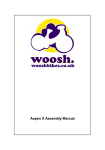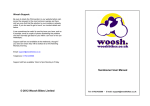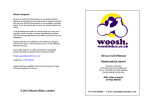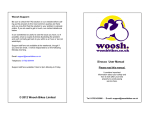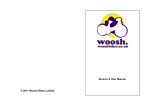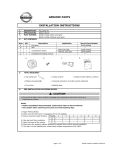Download Aspen II Assembly Manual.pub
Transcript
Aspen X Assembly Manual © 2012 Woosh Bikes Limited Warning: Two people are required when lifting/moving the carton. Introduction: Congratulations on your purchase of a Woosh electric cycle. Your Woosh electric cycle comes mostly assembled, but obviously to enable the cycle to be flat-packed, some parts of the cycle require a small amount of assembly to be completed before use. This manual assumes you are reasonably competent with and have your own toolkit. Disclaimer: You are responsible for the correct assembly and ongoing maintenance of your cycle. Woosh Bikes Ltd. accepts no responsibility for any incidents that may arise as a result of bikes which have been poorly assembled/maintained by the end user. All steps in this booklet must be completed to ensure trouble-free and safe operation. Maintenance: IMPORTANT An electric bike has far more components than a standard bike, and the rear wheel weighs 5 times more than a standard bike wheel due to the weight exerted by the battery and motor. Regular maintenance at least once every two weeks and once a week if you are a commuter or high mileage rider is therefore essential and should be done thoroughly. ALL fixings, spokes, handlebars, saddle and pedals must be checked and correctly tightened. Failure to do so could cause a cycle malfunction and result in safety issues for which Woosh Bikes Ltd. will not be held responsible. Failure to carry out this maintenance will also void the warranty. Essential extra steps that must be taken before riding the bike for the first time (and also regularly thereafter): All items on the bike should be double checked to ensure that all parts are correctly fitted and that all the nuts and bolts are as tight as they should be. This step should be repeated after one week of use, and then at regular intervals and every one to two weeks thereafter. The tyres need to checked/pumped up. The pressure range is between 40 to 65 psi depending on the weight of the user. It is essential that the tyres are regularly checked - again, every one to two weeks—to ensure that the pressures are correct. Failure to do so will shorten the life of your bike and will cause additional stress to the components of the bike. Due to the heavy weight exerted on the rear wheel of the bike by the battery and the motor (5 times more than on a standard bike wheel), both wheels and all spokes must be checked before initial riding and regularly thereafter . We recommend every 2 weeks and weekly if you are a commuter or high mileage rider. If any spokes are slightly loose it is essential to tighten them and true the wheel before riding your bike. Failure to observe this step could result in complete failure of the rear wheel and thus possible danger to the rider. The tool for truing/tightening the spokes can be purchased from most bike shops for approx. £3 or from us (please add £1 carriage). For details on how to true your wheels, see the support section of our website at www.wooshbikes.co.uk Alternatively, your local bike shop will be able to do this for you for a small charge (not refundable by us). The brakes need to be checked to ensure they are operating correctly, and if necessary adjusted to ensure optimum performance. If you are unsure about how to carry out any of these steps you should contact your local bike shop. Their fees will be payable by you and will not be refunded by us. Step 1 – Opening the carton. Keep the carton upright, remove the shipping straps and cut the tape seals. Remove the wheel from the carton, being careful not scratch the bike as you do this. Now lift the bike out of the carton and lean it against a sturdy surface/wall. Do not destroy the carton as it will be required if the bike needs to be returned for any reason in the future. Step 2 – Unpacking Cut the cable ties and detach the pedals, handlebars and charger etc. from the bike, and then remove the remaining packaging materials. Once the packaging has been removed, undo the bolts that hold the handle-bar clamp in place and remove the clamp. Line up the handle-bars and then replace the clamp to secure the handle-bars in place. There is a ribbed section on the handle-bars, this should sit centrally within the bracket. Step 3 – Front Wheel Lift the front of the bike slightly and remove the protective plastic from the front forks. Place front of bike gently back down. Fetch the front wheel and loosen off the fixings on either side if necessary to allow the wheel to be fitted. You may wish to turn the bike upside down to fit the wheel, but if you aren’t able to, follow the steps below. Charging the battery: To recharge the battery, lift the handle on the battery at the rear of the bike, attach the charger to the socket on the right side of the battery as shown below. Plug the other end into the mains. The battery does not have to be removed from the bike to be charged, but it can be removed and charged in another location if you prefer. There is a small indicator on the charger which glows red while charging and changes to green when charging is complete. Lift the front of the bike holding the bike frame and then carefully lower the bike onto the wheel ensuring that the wheel is seated in the correct position. Finger tighten the nuts/clamp on either side of the wheel so that when the clamp is engaged, the wheel is fully secured You can now use the ‘bike stand’ to keep the bike upright. Before attempting to ride the bike, please be sure to completely read and understand the user-manual which was included with your bike. Step 7 – Front Mudguard Step 4 – Front Brakes Remove the packaging from the mudguard if you haven’t already done so. Remove the nut from the bolt just behind the front brake assembly, this also secures the light, so be careful not to let the light fall. Offer up the mudguard tag to the rear side of the frame and then finger tighten the nut back into position. Fit the curved metal section into the receptacle on the left of the brake assembly. You may need to loosen the cable clamp on the right side of the brake assembly to do this. Re-tighten the brake cable clamp ensuring the correct tension and the correct position of the brake-pads with relation to the wheel rim. You may need to adjust the position of the brake pads, use the supplied Allen key to do this. For a guide on adjusting your brakes, see the support section of our website at www.wooshbikes.co.uk Secure the silver arms to the front forks using the bolts provided, and then adjust the height if required and then tighten the nut securing the tag. It may be necessary to angle the silver arms to get the best clearance from the tyre, as shown below. Now is a good time to release the front suspension which is locked for transit purposes, this is done by twisting the cap above the right fork. Failure to observe this step will result in an uncomfortable ride and excessive rattling of the bike. Step 5 – Saddle Step 6 - Pedals The saddle is already fitted, but to adjust the height of the saddle, open the clamp and position the saddle at the desired height and then close the clamp to lock the saddle into position. It may be necessary to tighten the thumb screw a little to ensure that when the clamp is closed the saddle is properly secured. The pedals are designed to fit on a specific side of the bike, do NOT attempt to fit the pedals without first checking which side of the bike the pedal is meant for. To identify which pedal goes on which side. The ‘R’ and ‘L’ indicates which side of the bike the pedal should be fitted to. Fit each pedal into position and hand tighten. Once each pedal has been tightened nearly all the way in by hand, use the 15mm spanner to fully secure the pedals in place. Note: turn the left pedal counter-clockwise to tighten.






